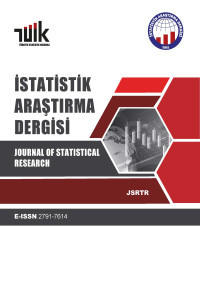Şehirleşme Seviyelerinin Projeksiyonu Üzerine Bir Araştırma
Bu çalışmada şehir-köy nüfus farkına (Urban-Rural Growth Differential = URGD) dayalı nüfus projeksiyon yöntemi tanıtılmış ve bu yöntem 1927'den beri yapılan nüfus sayınlarının şehir ve köy nüfusu ile ilgili kayıtlarından Türkiye'deki şehirleşme eğilimi araştırılmıştır. Farklı nüfus artış hızı varsayımları altında, şehir ve köy nüfusu artışı hızı net farkına dayanan ve şehirleşme seviyesinin lojistik dağılış gösterdiği varsayımını kullanan bir yöntemle şehir nüfusunun 2005 yıllarına ait şehirleşme seviyeleri ve şehirlerde yaşayacağı tahmin edilen nüfus sayıları hesaplanmıştır.
Anahtar Kelimeler:
Şehir Nüfusu, Köy Nüfusu, Şehir-Köy Nüfus Farkı, Nüfus Projeksiyon Yöntemi
A Study on the Projection Levels of Urbanization
Among many demographic measurements, urbanization level which is defined as the ratio of the urban population to the total population has become an important statistics for developing countries in which relatively high population increases are taking place. In the present study, the records of changes in urban and rural population of Turkey since 1927 were used to investigate the trend of urbanization in Turkey. The method which actually depends on the net difference between growth rates of urban rural populations and urban rural growth differential (URGD) was used for the projection of the total urban population until the year 2005 under different assumptions of population growth. The results of the projections have indicated that the level of urbanization in the year 2005 is about 70% and the total urban population in this year has been predicted to be around 50 millions. It also has been predicted that both the number of cities populated over 100.000 and the population living in these cities would continue to rise no matter which assumption for population growth is employed.
Keywords:
Urban Population, Rural Population, URGD,
___
- BAILEY, N.T.J. (1977), Mathematics, Statistics and Systems for Health. John Wiley and Sons. N.Y.
- CILLOV, H. (1982), Aşırı Nüfus Sorunu. Nüfus Bilim Dergisi, Cilt 4. 3-5.
- COX, P.R. (1970), Demography. Cambridge Univ. Press. London.
- Genel Nüfus Sayımı (1970, 1975, 1980, 1985, 1990), Başbakanlık Devlet istatistik Enstitüsü Yayınları.
- HOUZHOUSEN, W. (1987), the Population Problem in Turkey (as Seen from the Perspective of a Foreign Donor). Nüfusbilim Dergisi, Cilt 9.63-73.
- İKİZ, F. ve I.M.WILSON (1987), the Analysis of Turkish Population Register Data for Demographic Purposes-A Case for Computerisation. The First International Conference on Statistical Computing. 30 March-2 April, 1987, İzmir.
- JOHNSON, N. L. ve S. KOTS. (1970), Continous Univariate Distributions- 1. John Wiley and Sons. N.Y.
- KELLEY, A. ve J. WILLIAMSON. (1984), Modelling the Urban Transition. Pop. and Dev. Rev. 10, no.3. 419-441.
- KPEKODO, G.M.K. (1982), Essentials of Demographic Analysis. Heinemad Ed. Books Ltd. London.
- MARKS, E.S., W.SELTER ve KJ. KROTKI. (1974), Population Growth Estimation. The population Council. N.Y.
- MOHAN, R. (1985), Urbanization in India's Future. Pop. and Dev. Rev. ll, no4. 619-645.
- ÖLÇEN, A.N.(1979), Nüfus Sorunu ve Toplum Sağlığının Ekonomik Analizi. H.Ü. Yayınları. D-27.
- POLLARD, A.H., F. YUSUF ve G.N. POLLARD. (1981), Demograpic Tecniques, Pergamon Press. Sydney.
- SHORTER, F.C., D. PASTA ve R. SENDEK. (1987), Computational Methods for Population Projection. The Population Projection. The Population Council. N.Y.
- STREETS, E. (1983), View of Population Projection Methods. MSc. Thesis. Reading Univ. England.
- ISSN: 1303-6319
- Başlangıç: 2002
- Yayıncı: TÜİK
Sayıdaki Diğer Makaleler
Karmaşık Örnekleme Planlarında Çeşitli Varyans Tahmin Yöntemleri ve Uygulama
Sağdan Sansürlü Veriler için Parametrik Regresyon Modeli ve Kemik İliği Naklinde Kullanımı
Yüksel TERZİ, Yüksel BEK, Mehmet Ali CENGİZ
Hipertansiyonun Tahmini için Çoklu Tahmin Modellerinin Karşılaştırılması
Mevlüt TÜRE, İmran KURT, Ebru YAVUZ, Turhan KÜRÜM
Rasgele Sıkıştırma Yoluyla Weibull Dağılımının Yeni Bir Karakterizasyonu
Sevgi YURT ÖNCEL, Fazıl ALİEV ALİOĞLU, Funda AYGÜN
Ekstrem Değer Teorisi ile Riskin Değeri (Var)'ın Tahmini
Türkiye'nin Sosyo-Ekonomik Yapısının Kanonik Korelasyon Analizi ile İncelenmesi
